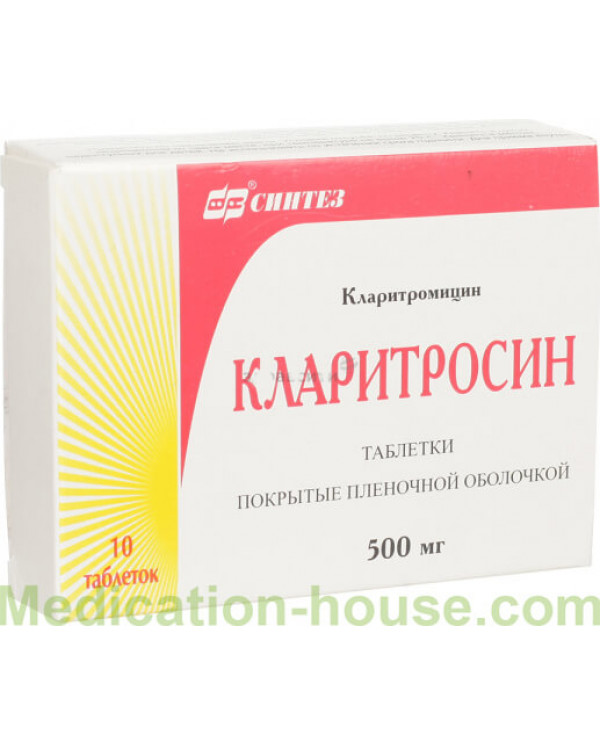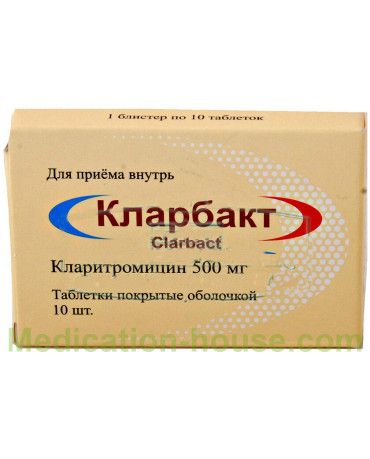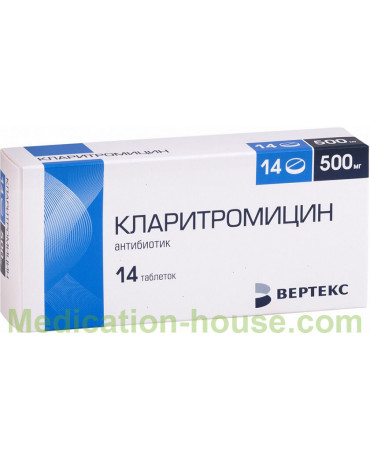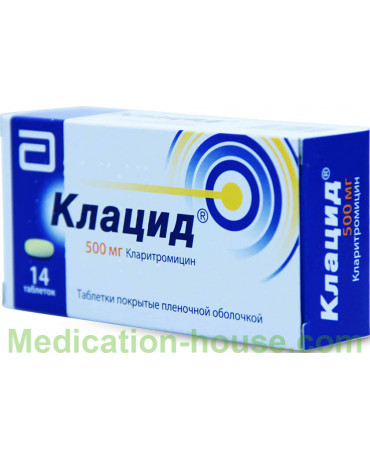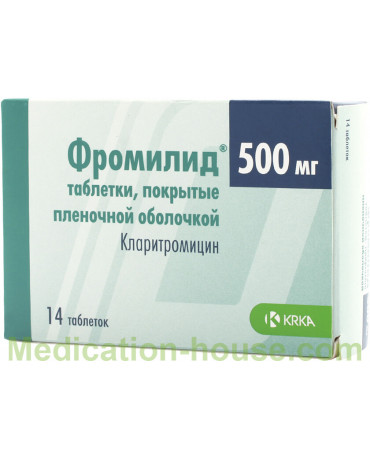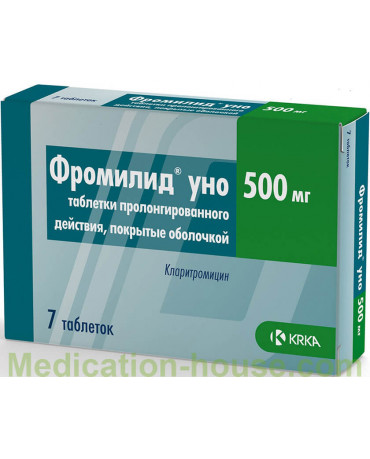Clarithrosin instruction
You can buy Clarithrosin here
Release form, composition and packaging
Tablets, coated yellow, oval.
1 tab.
clarithromycin 500 mg
Excipients: microcrystalline cellulose, polyvinylpyrrolidone (povidone), lactose, potato starch, colloidal silicon dioxide (aerosil), magnesium stearate, talc.
The composition of the shell: hydroxypropyl methylcellulose (hypromellose) or hydroxypropyl methyl cellulose, titanium dioxide, polyethylene oxide 4000 (polyethylene glycol 4000), tropeolin O.
pharmachologic effect
Semisynthetic antibiotic from the group of macrolides II generation. It has a wide range of antibacterial action. It violates the synthesis of protein of microorganisms (binds to the 50S subunit of the ribosome membrane of the microbial cell), acts on most pathogens bacteriostatic. The metabolite of clarithromycin 14-hydroxylarithromycin has its own antibacterial activity (against Haemophilus influenzae, it is superior to the activity of clarithromycin itself). The production of β-lactamase does not affect the activity of clarithromycin.
Active against gram-positive aerobic microorganisms: Streptococcus spp. (including Streptococcus pneumoniae, Streptococcus pyogenes, Streptococcus viridans, Streptococcus agalactiae), Staphylococcus spp. (including Staphylococcus aureus), Listeria monocytogenes, Corynebacterium spp .; Gram-negative organisms: Haemophilus influenzae, Haemophilus parainfluenzae, Haemophilus ducreyi, Moraxella (Branhamella) catarrhalis, Bordetella pertussis, Neisseria gonorrhoeae, Neisseria meningitidis, Pasteurella multocida, Campylobacter jejuni, Helicobacter pylori, Borrelia burgdorferi; intracellular microorganisms: Legionella pneumophila, Chlamydia trachomatis, Chlamydia pneumoniae, Mycoplasma pneumoniae, Ureaplasma urealyticum; anaerobic microorganisms: Bacteroides melaninogenicus, Clostridium perfringens, Eubacterium spp., Peptococcus spp., Propionibacterium spp. (including Propionibacterium acnes); Mycobacterium Mycobacterium spp. (including Mycobacterium avium, Mycobacterium intracellulare, Mycobacterium leprae and others, except Mycobacterium tuberculosis); protozoa: Toxoplasma gondii.
Clarithromycin acts bactericidal against Haemophilus influenzae, Streptococcus pneumoniae, Streptococcus pyogenes, Streptococcus agalactiae, Moraxella (Branhamella) catarrhalis, Neisseria gonorrhoeae, Campylobacter spp.
Gramin-negative microorganisms of the Enterobacteriaceae and Pseudomonas spp. Family are resistant to clarithromycin.
Pharmacokinetics
Suction
Clarithromycin is resistant to hydrochloric acid, is the most acid-resistant macrolide. When ingested, clarithromycin is well and rapidly absorbed. Bioavailability is 50-55%. Food slows down absorption without significantly affecting bioavailability. After a single dose, 2 peaks of the maximum concentration are recorded. The second peak is due to the ability of Clarithrosin to concentrate in the gallbladder, followed by a gradual or rapid release. Tmax when taking the drug in a dose of 250 mg - 1-3 hours.
Distribution
Plasma protein binding - no more than 90%. With regular intake of 250 mg / day, the Css of the unchanged drug and its main metabolite is 1 μg / ml and 0.6 μg / ml, respectively; T1 / 2 - 3-4 hours and 5-6 hours, respectively. When increasing the dose to 500 mg / day, the Css of unchanged drug and its plasma metabolite is 2.7–2.9 µg / ml and 0.83–0.88 µg / ml, respectively; T1 / 2 - 4.8-5 h and 6.9-8.7 h, respectively. At therapeutic concentrations, it accumulates in the lungs, skin, and soft tissues (in which the concentration is 10 times higher than the level in blood serum).
Metabolism
After ingestion of 20% of the dose taken, it is rapidly hydrolyzed in the liver by cytochrome P450 enzymes with the formation of the main metabolite, 14-hydroxylarithromycin, with pronounced antimicrobial activity against Haemophilus influenzae.
Removal
Excreted by the kidneys and with feces (20-30% - unchanged, the rest - in the form of metabolites). With a single dose of 250 mg and 1.2 g, 37.9% and 46% are excreted in the urine, and 40.2% and 29.1% in the feces, respectively.
Clarithrosin: DOSAGE
For adults, the average dose for oral administration is 250 mg 2 times / day. If necessary, you can assign 500 mg 2 times / day. The duration of treatment is 6-14 days.
For children, Clarithrosin is prescribed at a dose of 7.5 mg / kg of body weight / day. The maximum daily dose is 500 mg. The duration of treatment is 7-10 days.
For the treatment of infections caused by Mycobacterium avium, Clarithrosin is administered orally for 1 g 2 times / day. The duration of treatment may be 6 months or more.
In patients with renal failure (CC less than 30 ml / min), the dose should be reduced by 2 times. The maximum duration of treatment in patients of this group should be no more than 14 days.
Overdose
Symptoms: nausea, vomiting, diarrhea, headache, confusion.
Treatment: it is necessary to immediately flush the stomach and prescribe symptomatic therapy. Hemodialysis and peritoneal dialysis do not lead to a significant change in the level of clarithromycin in serum.
Drug interactions
While taking Clarithrosin, it increases the concentration of drugs metabolized in the liver with the help of cytochrome P450 enzymes (indirect anticoagulants, carbamazepine, theophylline, astemizole, cisapride, terfenadine / by 2–3 times), triazolam, midazolam, cyclosporine, dyspiramidine, cisapride, terfenadine / 2-3 times /, triazolam, midazolam, cyclosporine, dyspiramine, cisapride, terfenadine /, 3–3 times /, triazolam, midazolam, cyclosporine, dyspiramine, cisapride, terfenadine (2–3 times), triazolam, midazolam, cyclosporine, diispiramide, 3-fold / triazolam, diispiramide, cefiramine, cysapropine, terfenadine, 2-fold / triazolam, midazolam, cyclosporine, dyspiramine, 3-fold / 3 lovastatin, digoxin, ergot alkaloids).
With simultaneous use of Clarithrosin with cisapride, pimozide, astemizole and terfenadine, an increase in their concentration in the blood is noted. At the same time, prolongation of the QT interval and development of cardiac arrhythmias, including ventricular paroxysmal tachycardia, ventricular fibrillation, and flutter or ventricular fibrillation, are possible.
Rare cases of acute necrosis of skeletal muscles that coincide in time with the simultaneous appointment of clarithromycin and HMG-CoA reductase inhibitors - lovastatin and simvastatin are reported.
There are reports of increased concentrations of digoxin in the plasma of patients receiving both digoxin and clarithromycin. In such patients, it is necessary to constantly monitor the content of digoxin in the serum in order to avoid digitalis intoxication.
Clarithromycin can reduce the clearance of triazolam and, thus, increase its pharmacological effects with the development of drowsiness and confusion.
The simultaneous use of clarithromycin and ergotamine (ergot alkaloids) can lead to acute ergotamine intoxication, manifested by severe peripheral vasospasm and impaired sensitivity.
Simultaneous administration of oral zidovudine and clarithromycin to HIV-infected adults can lead to a decrease in equilibrium concentrations of zidovudine. Considering that clarithromycin probably alters the absorption of simultaneously administered oral zidovudine, this interaction is largely avoided by taking clarithromycin and zidovudine at different hours of the day (at least 4 hours apart).
With the simultaneous appointment of clarithromycin and ritonavir, the serum concentration of clarithromycin increases. Correction of the dose of clarithromycin in these cases for patients with normal renal function is not required. However, in patients with QA from 30 to 60 ml / min, the dose of clarithromycin should be reduced by 50%. When QA is less than 30 ml / min, the dose of clarithromycin should be reduced by 75%. With simultaneous treatment with ritonavir, clarithromycin should not be administered in doses of more than 1 g / day.
Pregnancy and lactation
Use of Clarithrosin during pregnancy and lactation is possible only in the case when the intended benefit to the mother outweighs the potential risk to the fetus.
Clarithromycin is excreted in breast milk, so if necessary, the appointment of the drug Clarithrosin during lactation should stop breastfeeding.
Clarithrosin: ADVERSE EFFECTS
On the part of the digestive system: often - nausea, dyspepsia, abdominal pain, vomiting, diarrhea; possibly - a violation of taste, transient increase in the activity of liver enzymes; rarely, hepatitis with elevated levels of liver enzymes in the blood and the development of cholestasis and jaundice. These damage to the liver in some cases were severe and, as a rule, reversible. In exceptional cases, liver failure was observed with a fatal outcome. There are reports of the development of pseudomembranous colitis (from medium to life-threatening), the development of glossitis, stomatitis, oral mucosa candidiasis and a change in the color of the tongue, the color of the teeth (in most cases it was reversible).
On the part of the central nervous system: headache, dizziness, anxiety, fear, fear, insomnia, nightmares, confusion, disorientation, hallucinations, psychosis, depersonalization; rarely - paresthesias.
On the part of the urinary system: rarely - an increase in serum creatinine concentration, interstitial nephritis, renal failure.
On the part of the senses: tinnitus, hearing loss (restored after discontinuation of Clarithrosin), changes in the perception of taste, usually arising together with a violation of taste.
On the part of the endocrine system: rarely - hypoglycemia (in some cases in patients who took hypoglycemic agents for oral administration or insulin during treatment with clarithromycin).
From the hematopoietic system: thrombocytopenia, leukopenia.
Since the cardiovascular system: in rare cases - prolongation of the QT interval, ventricular arrhythmia (including ventricular paroxysmal tachycardia), flutter or ventricular fibrillation.
Allergic reactions: urticaria, skin rash, anaphylaxis, Stevens-Johnson syndrome.
Terms and conditions of storage
Clarithrosin should be stored in a dry, dark place, out of reach of children at a temperature not higher than 25 ° C. Shelf life - 2 years.
Indications for Clarithrosin
Treatment of infectious and inflammatory diseases caused by causative agents that are sensitive to clarithromycin:
lower respiratory tract infections (bronchitis,
pneumonia);
infections of the upper respiratory tract (pharyngitis,
sinusitis);
otitis
infections of the skin and soft tissues (folliculitis,
erysipelas);
common or localized mycobacterial infections,
caused by Mycobacterium avium and Mycobacterium intracellulare;
localized infections
caused by mycobacterium chelonae,
Mycobacterium fortuitum and Mycobacterium kansasii;
for eradication of Helicobacter pylori and reduce the frequency of recurrence of duodenal ulcer.
Contraindications
severe abnormal liver function;
severe renal impairment;
simultaneous reception of ergot derivatives;
simultaneous administration of cisapride
pimozide
astemizole and terfenadine;
Hypersensitivity to macrolide antibiotics.
special instructions for Clarithrosin
In chronic liver diseases, it is necessary to regularly monitor serum enzymes.
With caution, Clarithrosin is administered simultaneously with drugs metabolized by liver enzymes (it is recommended to monitor drug concentrations in the blood).
In the case of co-administration with warfarin or other indirect anticoagulants, it is necessary to control the prothrombin time.
With a history of heart disease, simultaneous use with terfenadine, cisapride, astemizole is not recommended.
Attention should be paid to the possibility of cross-resistance between clarithromycin and other macrolide antibiotics, as well as lincomycin and clindamycin.
With prolonged or repeated use of Clarithrosin may develop superinfection (growth of insensitive bacteria and fungi).
Use in violation of kidney function
In patients with renal failure (CC less than 30 ml / min), the dose should be reduced by 2 times.
Contraindicated in severe renal impairment.
Use in violation of the liver
Contraindicated in severe violations of the liver.
Terms of sell
You don't need a prescription to buy Clarithrosin.

